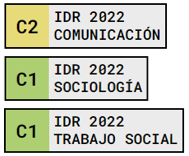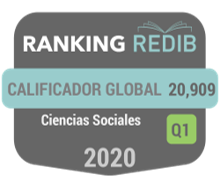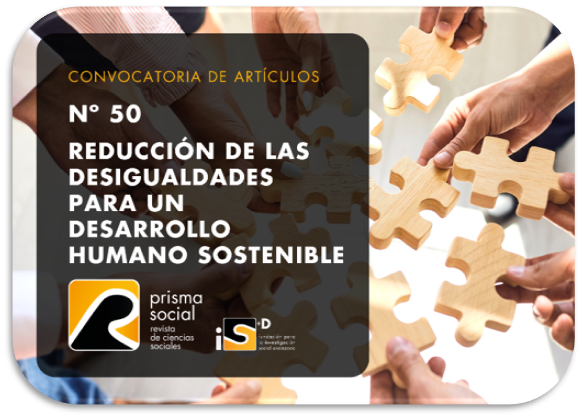Conservatives groups on TikTok: Social Polarization in Peru
Keywords:
Conservatives groups, Social Polarization, TikTok, Political Communication, Peru, Discourse, Far Right, Hate speechAbstract
TikTok’s infotainment exposes users to disturbing and harmful content, mainly broadcast by conservative groups. In this paper, we analyze the political uses from conservative groups during the social polarization in Peru in 2022. Fake news, harassing messages and promoting violence go unnoticed due to the application's lax security of the app. From a qualitative perspective of an exploratory study, we studied videos and comments on TikTok from conservative groups, regarding only the ones with inappropriate content that is still available and violates TikTok’s policies. Findings show that these groups produce discourses that assume protective positions from moral privileges that represent current fears in hypothetical futures (temporary-dystopian), build their communication from the perspective of the forgotten man or the deprivation of privileges (actor-victimizer) and isolate demands from political to an individual (sacralized-spatial) perspective. We have categorized our findings as follows: a) unsatisfaction, b) deprivation, c) relegation and d) oblivion. This article seeks to contribute to the initial research on the political-communicative uses of TikTok.
Downloads
References
Barrenechea, R., & Dargent, E. (2020). Populists and technocrats in Latin America: Conflict, cohabitation, and cooperation. Politics and Governance, 8(4), 509–519. https://doi.org/10.17645/PAG.V8I4.3333
Bautista, P. S., Alonso-López, N., & Giacomelli, F. (2021). Fact-checking in TikTok. Communication and narrative forms to combat misinformation. Revista Latina de Comunicación Social, 2021(79), 87–113. https://doi.org/10.4185/RLCS-2021-1522
Cánepa, G. (2016). Cultural management and neoliberal governmentality: The participation of Perú in the exhibition Inca-Kings of the Andes. En O. Kaltmeier & M. Rufer (Eds.), Entangled Heritages: Postcolonial Perspectives on the Uses of the Past in Latin America (87-108). Taylor and Francis. https://doi.org/10.4324/9781315579849
Cánepa Koch, G. (2020). El neoliberalismo como régimen cultural: gubernamentalidad y ciudadanías performativas. En G. Cánepa Koch & L. Lamas Zoeger (Eds.), Épicas del neoliberalismo: subjetividades emprendedoras y ciudadanías precarias (pp. 59–127). Pontificia Universidad Católica del Perú.
Catalá, J., & Vich, V. (2021). Boom and bust of euphoric narratives: Peruvian football and the neoliberal mentality. Soccer and Society, 23(6), 560-573. https://doi.org/10.1080/14660970.2021.1952186
Cervi, L., & Marín-Lladó, C. (2021). What are political parties doing on tiktok? The spanish case. Profesional de la información, 30(4), 1-17 https://doi.org/10.3145/EPI.2021.JUL.03
Contreras, B., & Martinez, M. (2021, September 16). Fed up with TikTok, Black creators are moving on. Los Angeles Times.
Cosamalón, J., & Durand, F. (2022). La república empresarial. Neoliberalismo, emprendedurismo y desigualdad (1990-2021). Derrama magisterial.
Courtés, J. (1991). Analyse sémiotique du discours. De l’énoncé à l’enonciation. Hachette.
Creswell, J. W. (2007). Qualitative Inquiry & Research Design. Choosing Among Five Approaches (Second Edition). Sage Publications.
Dargent, E. (2021). El páramo reformista. Un ensayo pesimista sobre la posibilidad de reformar el Perú. Pontificia Universidad Católica del Perú.
DeCook, J. R. (2018). Memes and symbolic violence: #proudboys and the use of memes for propaganda and the construction of collective identity. Learning, Media and Technology, 43(4), 485–504. https://doi.org/10.1080/17439884.2018.1544149
Dietrich, D. R. (2014). Rebellious Conservatives: Social Movements in Defense of Privilege. Palgrave Macmillan.
Drinot, P. (2017). Introducción. El Perú en teoría. En P. Drinot (Ed.) El Perú en teoría (pp. 9–31). Instituto de Estudios Peruanos.
Evolvi, G. (2019). #Islamexit: inter-group antagonism on Twitter. Information, Communication and Society, 22(3), 386–401. https://doi.org/10.1080/1369118X.2017.1388427
Forti, S. (2021). Extrema derecha 2.0. Qué es y cómo combatirla. Siglo Veintiuno.
Giglietto, F., & Lee, Y. (2017). A Hashtag Worth a Thousand Words: Discursive Strategies Around #JeNeSuisPasCharlie After the 2015 Charlie Hebdo Shooting. Social Media + Society, 3(1), 1-15. https://doi.org/10.1177/2056305116686992
Greenhalgh, S. P., Willet, K. B. S., & Koehler, M. J. (2019). Approaches to Mormon Identity and Practice in the #ldsconf Twitter Hashtag. Journal of Media and Religion, 18(4), 122–133. https://doi.org/10.1080/15348423.2019.1696121
Greimas, A. J., & Courtés, J. (1979). Sémiotique. Dictionnaire raisonné de la théorie du langage. Hachette.
Hirsch, E. (2020). Hidden treasures: Marca Perú (PeruTM) and the recoding of neoliberal indigeneity in the Andes. Latin American and Caribbean Ethnic Studies, 15(3), 245–269. https://doi.org/10.1080/17442222.2020.1798077
Instituto de Estudios Peruanos. (2021). IEP Informe de Opinión – Mayo IV 2021. Intención de voto - Elecciones Generales 2021. Segunda vuelta. https://iep.org.pe/wp-content/uploads/2021/05/Informe-IEP-OP-mayo-IV-2021-Intencion-de-voto-Segunda-vuelta-Elecciones-Generales-2021.pdf
Iqbal, M. (2022, May 25). Tiktok Revenue and Usage Statistics. Business of Apps. https://www.businessofapps.com/data/tik-tok-statistics/
Jaramillo-Dent, D., Contreras-Pulido, P., & Pérez-Rodríguez, A. (2022). Immigrant Influencers on TikTok: Diverse Microcelebrity Profiles and Algorithmic (In)Visibility. Media and Communication, 10(1), 208–221. https://doi.org/10.17645/mac.v10i1.4743
Kress, G., & Van Leeuwen, T. (2001). Multimodal discourse. The modes and media of contemporary communication discourse. Hodder Arnold
Latour, B. (1998). Petite philosophie de l’énonciation. En P. Basso & L. Corrain (Eds.), Eloquio di senso. Dialoghi semiotici per Paolo Fabbri, Orizzonti, compiti e dialoghi della semiotica. Saggi per Paolo Fabbri. (pp. 71–94). Costa & Nolan.
Le Compte, D. & Klug, D. (2021). “It’s Viral!” - A Study of the Behaviors, Practices, and Motivations of TikTok Users and Social Activism. Proceedings of the ACM Conference on Computer Supported Cooperative Work, CSCW, 108–111. https://doi.org/10.1145/3462204.3481741
Logrieco, G., Marchili, M. R., Roversi, M., & Villani, A. (2021). The paradox of tik tok anti-pro-anorexia videos: How social media can promote non-suicidal self-injury and anorexia. International Journal of Environmental Research and Public Health, 18(3), 1–4. https://doi.org/10.3390/IJERPH18031041
Lossio Chávez, F. (2019). La nación en tiempos especulativos o imperativos culturales de las marcas país. En G. Cánepa Koch & F. Lossio Chávez (Eds.), La nación celebrada. Marca país y ciudadanías en disputa (pp. 67–98). Universidad del Pacífico / Pontificia Universidad Católica del Perú / CRIC.
Martuccelli, D. (2015). Lima y sus arenas. Poderes sociales y jerarquías culturales. Cauce.
Medina Serrano, J. C., Papakyriakopoulos, O., & Hegelich, S. (2020). Dancing to the Partisan Beat: A First Analysis of Political Communication on TikTok. WebSci 2020 - Proceedings of the 12th ACM Conference on Web Science, 157–166. https://doi.org/10.1145/3394231.3397916
Miao, W., Huang, D., & Huang, Y. (2021). More than business: The de-politicisation and re-politicisation of TikTok in the media discourses of China, America and India (2017–2020). Media International Australia. Advance online publication. https://doi.org/10.1177/1329878X211013919
Miller, C. (2022). How Modern Witches Enchant TikTok: Intersections of Digital, Consumer, and Material Culture(s) on #WitchTok. Religions, 13(2), 1-22. https://doi.org/10.3390/rel13020118
Mudde, C. (2021). La ultraderecha hoy. Paidós.
Ohlheiser, A. (2021, February 24). The beauty of TikTok’s secret, surprising, and eerily accurate recommendation algorithms. MIT Technology Review. https://www.technologyreview.com/2021/02/24/1017814/tiktok-algorithm-famous-social-media/
Peña-Fernández, S., Larrondo-Ureta, A., & Morales-I-gras, J. (2022). Current affairs on TikTok. Virality and entertainment for digital natives. Profesional de la información, 31(1), 1-13. https://doi.org/10.3145/epi.2022.ene.06
Perez, S. (2021, February 3). TikTok to flag and downrank ‘unsubstantiated’ claims fact checkers can’t verify. Join TechCrunch. https://techcrunch.com/2021/02/03/tiktok-to-flag-and-downrank-unsubstantiated-claims-fact-checkers-cant-verify/
Poretskova, A. A., & Savin, N. Y. (2021). Memes as Consolidation Tool of the Protest Movement (Evidence from Short Videos on the Social Netword TikTok). Monitoring Obshchestvennogo Mneniya: Ekonomicheskie i Sotsial’nye Peremeny, 6, 76–96. https://doi.org/10.14515/monitoring.2021.6.2030
Sánchez-Castillo, S., & Mercado-Sáez, M. T. (2021). I suffer from a serious rare disease: A challenge to sing and choreograph on TikTok. Profesional de la información, 30(4), 1-17. https://doi.org/10.3145/EPI.2021.JUL.14
Schaffar, W. (2021). “I Am not Here for Fun”: The Satirical Facebook Group Royalists Marketplace, Queer TikToking, and the New Democracy Movement in Thailand: An Interview With Pavin Chachavalpongpun. Austrian Journal of South-East Asian Studies, 14(1), 129–137. https://doi.org/10.14764/10.ASEAS-0039
Schmitz, M., & Espinosa, A. (2015). Impact of Dissonant Information about the Peruvian Brand Campaign on National Identity and Social Well-Being. Universitas Psychologica, 14(1), 329–338. https://doi.org/10.11144/JAVERIANA.UPSY14-1.IIDC
Sherman, A. (2020, June 24). TikTok reveals detailed user numbers for the first time. CNBC. https://www.cnbc.com/2020/08/24/tiktok-reveals-us-global-user-growth-numbers-for-first-time.html
Silverman, H. (2015). Branding Peru: Cultural heritage and popular culture in the marketing strategy of PromPerú. En, M. Robinson y H. Silverman. (Eds) Encounters with Popular Pasts: Cultural Heritage and Popular Culture. (pp.131–148). Springer. https://doi.org/10.1007/978-3-319-13183-2_8
Stake, R. E. (1999). Investigacio?n con estudio de casos. Ediciones Morata.
Strauss, A. L., & Corbin, J. M. (2002). Bases de la investigacio?n cualitativa: te?cnicas y procedimientos para desarrollar la teori?a fundada. Universidad de Antioqui?a
TikTok. (2022, Febrero). Normas de la comunidad. https://www.tiktok.com/community-guidelines?lang=es
Trejo, J. S. (2019). From Romana Gens to cumbiatella: Propaganda, migration and identity in Italo-Peruvian mobilities. Modern Italy, 24(1), 21–44. https://doi.org/10.1017/mit.2018.28
Ubilluz, J. C. (2021). Sobre héroes y víctimas. Ensayos para superar la memoria del conflicto armado. Taurus.
Uribe del Águila, V. (2019). «Marca Perú/Mata Perú»: ciudadanía, crítica y censura en torno al logo de marca país. En G. Cánepa Koch & F. Lossio Chavez (Eds.), La nación celebrada. Marca país y ciudadanías en disputa (pp. 161–180). Universidad del Pacífico / Pontificia Universidad Católica del Perú / CRIC.
Vijay, D., & Gekker, A. (2021). Playing Politics: How Sabarimala Played Out on TikTok. American Behavioral Scientist, 65(5), 712-734. https://doi.org/10.1177/0002764221989769
Villanueva Mansilla, E. (2021). Rápido, violento y muy cercano. Las movilizaciones de noviembre de 2020 y el futuro de la política digital. Pontificia Universidad Católica del Perú
Vizcaíno?Verdú, A. & Aguaded, I. (2022). #ThisIsMeChallenge and Music for Empowerment of Marginalized Groups on TikTok. Media and Communication, 10(1), 157–172. https://doi.org/10.17645/mac.v10i1.4715
Warren, Á. (2020). Altars for the Morrigan: the legitimizing agency of a goddess in the networked flow of authority of a YouTube sub-culture. Journal of Contemporary Religion, 35(2), 287–305. https://doi.org/10.1080/13537903.2020.1761632
Weimann, G., & Masri, N. (2020a). Research Note: Spreading Hate on TikTok. Studies in Conflict and Terrorism, 1, 1-14. https://doi.org/10.1080/1057610X.2020.1780027
Weimann, G., & Masri, N. (2020b, Mayo 4). The Virus of Hate: Far-Right Terrorism in Cyberspace. International Institute for Counter-Terrorism. https://www.ict.org.il/Article/2528/The_Virus_of_Hate.
Wheatstone, R., & O’Connor, C. (2020, Marzo 1). Cesspit of Hate. Tiktok Swamped with sickening Vidos of Terror Attacks Muders, Holocaust Denials and Vile Racist Slurs. The Sun. https://www.thesun.co.uk/news/10962862/tiktok-extremist-racist-videos-anti-semitism/
Wood, M. A., & McGovern, A. (2021). Memetic copaganda: Understanding the humorous turn in police image work. Crime, Media, Culture, 17(3), 305–326. https://doi.org/10.1177/1741659020953452
Zhang, M., & Liu, Y. (2021). A commentary of TikTok recommendation algorithms in MIT Technology Review 2021. Fundamental Research, 1(6), 846–847. https://doi.org/10.1016/j.fmre.2021.11.015
Zulli, D., & Zulli, D. J. (2020). Extending the Internet meme: Conceptualizing technological mimesis and imitation publics on the TikTok platform. New Media and Society, 24(8), 1-19. https://doi.org/10.1177/1461444820983603
Downloads
Published
How to Cite
Issue
Section
License
Copyright (c) 2022 Revista Prisma Social

This work is licensed under a Creative Commons Attribution-NonCommercial-NoDerivatives 4.0 International License.
Los derechos de edición pertenecen a la Fundación iS+D para la Investigación Social Avanzada, entidad que edita la Revista Prisma Social, y es necesario su permiso para cualquier reproducción. En todo caso, será necesario citar la procedencia de cualquier reproducción total o parcial.
La publicación de artículos o reseñas en la Revista Prisma Social no da derecho a remuneración alguna.
Política de acceso abierto
La publicación de la Revista Prisma Social y su difusión se realiza de forma abierta a través de Internet.
La Revista Prisma Social ofrece acceso libre y abierto inmediato a su contenido de forma totalmente gratuita con el fin de hacer llegar la investigación científica a toda la sociedad y con el objetivo de crear una cultura reflexiva encaminada a la comprensión de los comportamientos sociales desde una perspectiva global.
Todos los contenidos digitales de la Revista Prisma Social son de acceso libre y gratuito y se publican bajo una licencia de Creative Commons:

está bajo una licencia de Creative Commons Reconocimiento-NoComercial-SinObraDerivada 3.0 España License.
Creado a partir de la obra en www.isdfundacion.org
Bajo esta licencia, está permitida la reproducción y difusión de los contenidos de la revista con fines educativos o de investigación, sin ánimo de lucro, siempre y cuando estos no se modifiquen, se cite la procedencia (Prisma Social, Revista de ciencias sociales), y la autoría.
Esta licencia a la que se acoge la Revista Prisma Social permite copiar, distribuir, exhibir los textos e imágenes de la revista, siempre que se cumplan las siguientes condiciones:
- Reconocimiento: Debe reconocerse y respetarse la autoría de la obra de la manera especificada por el autor y la entidad editora (Revista Prisma Social – Fundación iS+D).
- No comercial: No se puede utilizar esta obra para fines comerciales.
- No derivados: No se puede alterar, transformar o generar una obra derivada a partir de esta obra.
Se deberán establecer claramente los términos de esta licencia para cualquier uso o distribución de los documentos. Se podrá prescindir de cualquiera de estas condiciones si se obtiene el permiso expreso del autor/a.
Desde la Revista de Prisma Social se permite y se invita a los/as autores/as a ampliar la visibilidad, alcance e impacto de sus artículos publicados en la revista mediante la redifusión (auto-archivo) de los mismos en:
1. Sus espacios web personales (web, blog, redes sociales, foros científicos, etc.).
2. Archivos abiertos institucionales (archivos universitarios, Hispana, Europeana, etc.).
3. Redes sociales de naturaleza académica y científica (ResearchGate, Academia.edu, Getcited.org).
Se requiere que en dichas publicaciones se detallen todos los datos bibliográficos de la publicación.
Para más información, puede descargar y consultar las Condiciones de Publicación:























.png)




